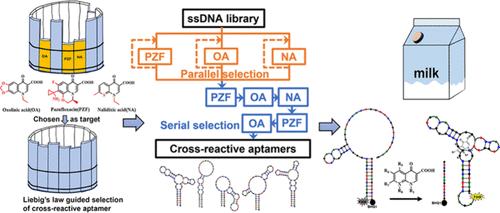当前位置:
X-MOL 学术
›
Anal. Chem.
›
论文详情
Our official English website, www.x-mol.net, welcomes your feedback! (Note: you will need to create a separate account there.)
Screening of Cross-Reactive Aptamers for the Detection of 24 Quinolones by Using a Liebig’s Law-Guided Parallel-Series Strategy
Analytical Chemistry ( IF 7.4 ) Pub Date : 2024-05-07 , DOI: 10.1021/acs.analchem.4c00616 Weijuan Yang, Dongdong Luo, Siyu Zheng, Yiru Zhang, Zongwen Wang, Fengfu Fu
Analytical Chemistry ( IF 7.4 ) Pub Date : 2024-05-07 , DOI: 10.1021/acs.analchem.4c00616 Weijuan Yang, Dongdong Luo, Siyu Zheng, Yiru Zhang, Zongwen Wang, Fengfu Fu

|
Quinolones, a widely used class of antibiotics, present significant environmental and health concerns if they excessively remain in the environment and in food. Aptamers specific to quinolones can be applied as bioreceptors for the detection of quinolone residues in the environment and food. The quinolone family contains dozens of different individuals that share the same core structure coupled with various substituents at six different positions. The diversity and complexity of the substitution sites make it a challenge to choose a set of representative molecules that encompass all the desired sites and preserve the core molecular framework for the screening of quinolone-specific aptamers via systematic evolution of ligands by exponential enrichment (SELEX). To address this challenge, we introduce a novel parallel-series strategy guided by Liebig’s law for isolating quinolone-specific cross-reactive aptamers by using the library-immobilized SELEX method. Through this approach, we successfully identified 5 aptamers (Apt.AQ01–Apt.AQ05) with high binding affinity and excellent specificity to 24 different quinolone individuals. Among them, Apt.AQ03 showcased optimal performance with affinities ranging from 0.14 to 1.07 μM across the comprehensive set of 24 quinolones, exhibiting excellent specificity against nontarget interferents. The binding performance of Apt.AQ03 was further characterized with microscale thermophoresis, circular dichroism spectra, and an exonuclease digestion assay. By using Apt.AQ03 as a bioreceptor, a fluorescence resonance energy transfer (FRET) aptasensor was developed for the detection of 24 quinolones in milk, achieving a remarkable detection limit of 14.5–21.8 ng/mL. This work not only establishes a robust and effective strategy for selecting cross-reactive aptamers applicable to other small-molecule families but also provides high-quality aptamers for developing various high-throughput and reliable methods for the detection of multiple quinolone residues in food.
中文翻译:

使用李比希定律引导的并行串联策略筛选用于检测 24 种喹诺酮类药物的交叉反应适体
喹诺酮类药物是一类广泛使用的抗生素,如果在环境和食品中过量残留,则会带来严重的环境和健康问题。喹诺酮类药物特异性适配体可作为生物受体用于检测环境和食品中的喹诺酮类药物残留。喹诺酮家族包含数十个不同的个体,它们共享相同的核心结构,并在六个不同位置上有不同的取代基。取代位点的多样性和复杂性使得选择一组包含所有所需位点的代表性分子并保留核心分子框架以通过指数富集配体系统进化(SELEX)筛选喹诺酮特异性适体成为一项挑战。为了应对这一挑战,我们引入了一种新的并联策略,该策略以李比希定律为指导,通过使用文库固定化 SELEX 方法分离喹诺酮特异性交叉反应适体。通过这种方法,我们成功鉴定了 5 个适体 (Apt.AQ01–Apt.AQ05),它们对 24 个不同的喹诺酮个体具有高结合亲和力和优异的特异性。其中,Apt.AQ03 在 24 种喹诺酮类药物中表现出最佳性能,亲和力范围为 0.14 至 1.07 μM,对非目标干扰物表现出优异的特异性。通过微尺度热泳动、圆二色光谱和核酸外切酶消化测定进一步表征了 Apt.AQ03 的结合性能。通过使用Apt.AQ03作为生物受体,开发了荧光共振能量转移(FRET)适配体传感器,用于检测牛奶中的24种喹诺酮类药物,实现了14.5-21.8 ng/mL的显着检测限。这项工作不仅为选择适用于其他小分子家族的交叉反应适体建立了稳健有效的策略,而且为开发各种高通量、可靠的食品中多种喹诺酮残留检测方法提供了高质量的适体。
更新日期:2024-05-07
中文翻译:

使用李比希定律引导的并行串联策略筛选用于检测 24 种喹诺酮类药物的交叉反应适体
喹诺酮类药物是一类广泛使用的抗生素,如果在环境和食品中过量残留,则会带来严重的环境和健康问题。喹诺酮类药物特异性适配体可作为生物受体用于检测环境和食品中的喹诺酮类药物残留。喹诺酮家族包含数十个不同的个体,它们共享相同的核心结构,并在六个不同位置上有不同的取代基。取代位点的多样性和复杂性使得选择一组包含所有所需位点的代表性分子并保留核心分子框架以通过指数富集配体系统进化(SELEX)筛选喹诺酮特异性适体成为一项挑战。为了应对这一挑战,我们引入了一种新的并联策略,该策略以李比希定律为指导,通过使用文库固定化 SELEX 方法分离喹诺酮特异性交叉反应适体。通过这种方法,我们成功鉴定了 5 个适体 (Apt.AQ01–Apt.AQ05),它们对 24 个不同的喹诺酮个体具有高结合亲和力和优异的特异性。其中,Apt.AQ03 在 24 种喹诺酮类药物中表现出最佳性能,亲和力范围为 0.14 至 1.07 μM,对非目标干扰物表现出优异的特异性。通过微尺度热泳动、圆二色光谱和核酸外切酶消化测定进一步表征了 Apt.AQ03 的结合性能。通过使用Apt.AQ03作为生物受体,开发了荧光共振能量转移(FRET)适配体传感器,用于检测牛奶中的24种喹诺酮类药物,实现了14.5-21.8 ng/mL的显着检测限。这项工作不仅为选择适用于其他小分子家族的交叉反应适体建立了稳健有效的策略,而且为开发各种高通量、可靠的食品中多种喹诺酮残留检测方法提供了高质量的适体。






























 京公网安备 11010802027423号
京公网安备 11010802027423号